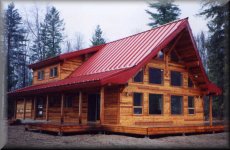






 How does Post and Beam fit into our environment |
|
Granby Post and Beam Homes has a very strong and sound committment to our environment and its ever increasing concerns. This committment is not only to our own local resource environment, in Southern British Columbia Canada; but also extends to the Global environment as well. This committment has grown out of the experiences gained over a 30 year period in the forests by the principle owner of granby; as well as other partners in production and employees. The wood used in Granby’s production has been harvested selectively, salvaged timber or purchased from responsible producers. These terms mean the following. Harvested Selectively: Standing trees have been carefully removed from the forest with great care as to not damage other trees. Once milled the timbers are graded for structural integrity as well as appearance and then air dried. This air drying includes stacking the timbers in a covered area so that the air can circulate around them. This is slow but very good way to reduce the moisture content to a point where the wood can be put into production. This slow drying reduces the natural checking ( cracking ) that you will find in all types of wood. Salvaged: These timbers Granby uses the most. This timber which is either dead or dieing. These trees include timber which has been killed by wild fire or disease and in some cases is even a danger to the public. Again these trees are harvested in a way as to avoid damaging other live trees. This type of tree is usually found in small groups and if found in a large concentration then portions of that concentration are reserved for the wildlife of that area; such as night hawks, owls and woodpeckers. This naturally dried wood provides some of the very highest quality possible. Longevity: The Post and Beam method of construction is one of the oldest surviving methods of construction on the planet. It has been used by virtually all cultures that had timber available for construction. The oldest surviving wooden structures in the world are built in the post and beam building method. It would be expected that a home built this way and properly maintained would have a lifetime longer than the age of the trees used to build it. This would take pressure off the environment to supply wood into homes that are for all intents and purposes disposable. Even at the end of the life span of a Post and Beam Home a certain amount of the timberwork would be able to be recycled. |
An exerp from the Newsletter Choices titled "A Change of Strategy" |
|
Our province is definitely not running out of wood. BC is growing more than it is harvesting, but, as forest industry consultant Don Reimer puts it, there is "a lot of that timber we can't get to. It's either in parks or protected areas, or restricted by environmental values because of increasing social pressure." Given the limitations on access to timber resources, the Forest Alliance commissioned a report to examine the issue and analyze ways of getting more from the commercial wood supply. The report centered its findings on different forestry management models for three distinct timber supply areas in the province. "We looked at various traditional approaches to increasing yield-growing trees faster, fertilization, things like that," says Reimer, one of several key consultants who contributed to the report. "You get some advantage there, but not a huge bang." The report also examined databases for growth in second generation forests a factor that had been traditionally under estimated and concluded that improving them would result in higher harvesting rates. (The BC Ministry of Forests has since increased its estimates of growth rates in regenerated forests by up to 30 percent.) But, Reimer feels, the report's key finding is this: the forest industry and the province will likely get the "biggest bang" from a new approach to forest management called habitat management. "This is a non traditional approach, and it asks, what if we change our management strategy? Instead of drawing lines on the ground and zoning areas relative to commercial timber productivity this area for aesthetics, that area for old growth under a habitat management approach, the whole forest works for you for a variety of purposes, to produce habitat, maintain riparian zones, plus recreation areas, plus viewshed, plus timber. In the US, this approach has been used to great advantage for all concerned." The province of Manitoba has also incorporated a habitat management approach into its 20 year forestry plan. "BC needs to get out of the box," says Reimer. "The commercial land base is not going to get bigger. If anything, there is going to be even more social pressure because of environmental and aesthetic needs. We need a land management strategy that doesn't focus only on defining commercial areas, but instead puts the dynamics of the entire forest base to work for you." |